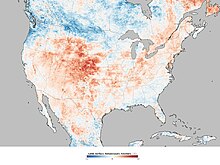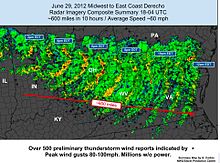2012 North American heat wave

In late June 2012 much of the United States and Canada began experiencing a record heat wave.[1]
The heat spread east from the Rocky Mountains and a massive high-pressure system over the Midwest caused triple-digit temperatures.[2]
On June 25, 2012, Denver, Colorado tied its all-time high with a temperature of 105°F (40.5°C). On the same day a couple of 113°F (45°C) readings were recorded in Kansas. The heat was so strong that Alamosa, Colorado broke their daily records for six consecutive days. In Galveston, Texas, the earliest 100°F day ever was recorded.[3]
In Northern Canada, Fort Good Hope, Northwest Territories had a streak of five consecutive days above 30°C (86°F) from June 21 to June 25, quite possibly the longest heat wave in Canada at that moment.[4]. Further south, on June 19, 20 and 21, Toronto experienced its first official heat wave of the season (a heat wave in Toronto is defined as three or more consecutive days with temperatures at or above 32°C (90°F)), with temperatures ranging between 33.4°C (92.1°F) and 34.5°C (94.1°F) and the minimum temperature on June 20 not dropping below 24.4°C (75.9°F)[5]. On July 4, Toronto reached 36.3°C (97.3°F)[6]. With temperatures higher than 32°C (90°F) predicted for the following two days, this three-day period is set to become the city's second official heat wave of the season.
On June 26, Hill City, Kansas was the warmest point in the United States with the thermometer climbing to 115°F (46.1°C).[7]
Thousands of records were being broken again on June 28. Fort Wayne, Indiana tied its all-time record high with 106°F (41.1°C) while Indianapolis broke its monthly record at 104°F(40°C). More monthly records that day included St. Louis, Missouri at 108°F (42.2°C) and Little Rock, Arkansas at 107°F (41.7°C).[8]
On June 28, 2012, wildfires raged across the western United States. The Waldo Canyon fire in Colorado attracted the most attention after spreading into Colorado Springs and charring hundreds of homes, but large wildfires also burned throughout Utah, Wyoming, Montana, New Mexico, Utah, and Arizona.[9]
The scorching heat continued on June 29 when Washington, D.C. and Atlanta, Georgia recorded their highest June temperature ever at 104°F(40°C). Charlotte, North Carolina and Raleigh, North Carolina were warm enough to tie the all-time record at 104°F(40°C) and 105°C(40.6°C) respectively.[10]

On June 29-30, 2012, The heat and humidity from the heat wave caused a small thunderstorm in Iowa to develop into a violent and unprecedented derecho, which tracked across the Midwest and Mid-Atlantic regions of the United States while causing 80 MPH or higher winds, doing hundreds of millions of dollars in damage, and downing trees and power lines, leaving 4 million people in the eastern U. S. without power.[11]
On July 4, Chicago's O'Hare International Airport tied its all-time 4th of July record of 102°F (38.89°C) which was set back in 1912 (a questionable record given its age, so Chicago likely hit an all-time record for the 4th of July this year). Not far from O'Hare, the official measuring station for the city of Chicago, the villages of Park Ridge, Niles, Norrige as well as much of the Chicago metropolitan area recorded a temperature of 104°F (40°F). Some places north of Chicago got even hotter. Caledonia, Wisconsin, just south of Milwaukee, Wisconsin reached 107°F. Actual air temperatures also teetered dangerously close to 110°F in and around the city of Allegan, Michigan.
As of July 5, Chicago has had 3 official 100°F or higher temperature readings, with an official high of 103°F at O'Hare on the 5th. Like the day before, temperatures were much higher in Park Ridge and in much of the metropolitan area of Chicago, with highs reaching 105°F and 106°F in some areas. These temperatures are extremely unusual for the city and the surrounding area. Normally, the highest temperature recorded on a typical Chicago summer is around 95°F, a temperature of 90°F is usually considered extreme, and the thermometer reaches or surpasses 100°F only once every 5 to 10 years.
As of July 4, 2012, St. Louis, MO has endured a string of 5 days with temperatures above 100 °F, and this is forecast to continue until July 7.[12]
There’s a high level of agreement among scientists that global warming has made it more likely that heat waves of this magnitude will occur.[13]
References
- ^ http://news.yahoo.com/nation-bakes-serious-heat-wave-hits-early-071629659.html;_ylt=A2KJjb3aIe9PhDEAUy7QtDMD
- ^ http://news.yahoo.com/extreme-heat-spreads-across-u-breaks-records-230935013.html;_ylt=A2KJjb3pJO9PnH4AWarQtDMD
- ^ http://www.accuweather.com/en/weather-news/alltime-record-highs-fall-in-p/67058
- ^ http://www.climate.weatheroffice.gc.ca/climateData/dailydata_e.html?StationID=27549&Month=6&Day=25&Year=2012&timeframe=2
- ^ http://www.climate.weatheroffice.gc.ca/climateData/dailydata_e.html?StationID=5097&Month=6&Day=1&Year=2012&timeframe=2
- ^ http://www.climate.weatheroffice.gc.ca/climateData/dailydata_e.html?StationID=5097&Month=7&Day=1&Year=2012&timeframe=2
- ^ http://www.kansascity.com/2012/06/27/3679925/hill-city-high-temperature-hits.html
- ^ http://www.storm2k.org/phpbb2/viewtopic.php?f=24&t=112849&start=60
- ^ http://www.nasa.gov/mission_pages/fires/main/usa/20120629-westernUS.html
- ^ http://www.washingtonpost.com/blogs/capital-weather-gang/post/washington-dc-ties-record-high-of-101/2012/06/29/gJQAiiRmBW_blog.html
- ^ http://www.newsday.com/news/nation/east-coast-storms-kill-13-cause-wide-power-outages-1.3815085
- ^ http://www.stltoday.com/news/local/metro/streak-of--degree-weather-in-st-louis-area-hits/article_69ca6f80-b235-5bfd-9985-9fcc82eb498e.html
- ^ http://www.nasa.gov/mission_pages/fires/main/usa/20120629-westernUS.html
External links
- Scorching Heat Roasts Eastern U.S. July 3, 2012 Scientific American
